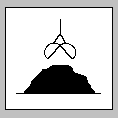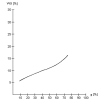| Beans, dried | [German version] |
Table of contents |
|
| General: | ||
| Product information | ||
| Packaging | ||
| Transport | ||
| Container transport | ||
| Cargo securing | ||
Product information
Product name
| German | Bohnen, getrocknet |
| English | Beans, dried |
| French | Haricots |
| Spanish | Judías |
| Scientific | Phaseolus vulgaris |
| CN/HS number * | 0713 30 ff. |
(* EU Combined Nomenclature/Harmonized System)
Product description
Beans are the seeds of the annual bean plants belonging to the legume family (Leguminosae) and are transported in dry form.
There are many different types and varieties of beans:
| pinto beans: elongate, red-brown speckled beans, similar in appearance to quail eggs (see Figure 3) | |
| haricot beans (see Figure 1) | |
| borlotti beans: red, sometimes speckled beans (see Figure 2) | |
| black beans: black, glossy beans | |
| kidney beans: red beans | |
| mung beans: olive green beans | |
| urd beans |
Quality / Duration of storage
New crop beans have a smooth, tight, close-fitting husk, while old crop beans are withered, slightly wrinkly and (in the case of haricot beans) discolored gray and no longer have good cooking properties.
It is very important for the surveyor to ascertain the year of harvest: it must be taken into consideration that the beans may be mixed with beans from the previous year’s harvest.
The maximum admissible admixture content is 1%, of which at most 0.5% is harmful (i.e. contamination by soil, small stones, seeds from other crop plants and weeds, empty legume husks, grain admixtures, legumes chewed and punctured by pests and crushed legumes).
Dried beans have a storage life of approx. 2 years.
Intended use
Beans have a high content of starch (58%) and protein (22%) and are among the highest protein foodstuffs, especially in Europe and East Asia.
Beans are primarily used as a staple in stews, salads and soups. Bean husks also have therapeutic uses.
Figures
(Click on the individual Figures to enlarge them.)
 Figure 1 |
 Figure 2 |
 Figure 3 |
 Figure 4 |
 Figure 5 |
Countries of origin
This Table shows only a selection of the most important countries of origin and should not be thought of as exhaustive.
| Europe | Italy, France, Spain, Bulgaria, Romania, Turkey |
| Africa | Ethiopia, Sudan, East Africa, Kenya, Senegal, Mali, Nigeria |
| Asia | China |
| America | Chile, Argentina, Brazil, USA, Canada |
| Australia |
Back to beginning
Packaging
Beans are packaged in, among other things, flat natural fiber fabric bags (50 – 100 kg jute or linen bags) or also in cartons, in which case the beans are heat-sealed in film bags.
When packaged in corrugated or millboard cartons, the product should be transported on pallets. The packaging size should be so selected that the dimensions of the individual area modules or area module multiples are conformed to the conventional pallet sizes (800×1200 mm and 1000×1200 mm) and cargo units may thus be produced.
 Figure 6 |
Back to beginning
Transport
Symbols
 General cargo |
 Bulk cargo |
Means of transport
Ship, truck, railroad
Container transport
Passively ventilated containers (coffee containers) subject to compliance with lower limits for water content of goods, packaging and container flooring.
Cargo handling
In damp weather (rain, snow), the cargo must be protected from moisture, since this may lead to mold, spoilage and self-heating.
Hooks must not be used in handling bagged goods as they subject the bags to point loads, so damaging them. Due to their shape, plate or bag hooks apply an area load and are thus more suitable for handling bags.
Stowage factor
| 1.70 m³/t (from Turkey, flat bag, 100 kg) [1] | |
| 1.34 m³/t (bulk cargo from Alexandria) [11] | |
| 1.84 – 1.98 m³/t (bags) [14] |
Stowage space requirements
Cool, dry, good ventilation
Segregation
Matting, jute coverings, fiber rope, thin fiber nets
Cargo securing
In order to ensure safe transport, the packages must be stowed and secured in the means of transport in such a manner that they cannot slip or shift during transport. If loss of volume and degradation of quality are to be avoided, the packages must not be damaged by other articles or items of cargo.
Back to beginning
Risk factors and loss prevention
RF Temperature
Beans require particular temperature, humidity/moisture and ventilation conditions (SC VII) (storage climate conditions).
Favorable travel temperature range: 5 – 25°C [1]
Almost all types of beans are sensitive to heat and should not be stowed near heat sources (engine room bulkhead, heated tanks) in order to reduce the risk of self-heating.
Drying-out and heat harden the bean husks.
Back to beginning
RF Humidity/Moisture
Beans require particular temperature, humidity/moisture and ventilation conditions (SC VII) (storage climate conditions).
| Designation | Humidity/water content | Source |
| Relative humidity | 65% | [1] |
| Water content | 8 – 15% | [1] |
| 16% | [14] | |
| Maximum equilibrium moisture content | 65% | [1] |
The lima bean (Phaseolus lunatus) has a water content of 9.8 – 12.4%, while that of the urd bean (Phaseolus mungo) is 9.4 – 13.0%.
Dried beans are highly hygroscopic and must therefore be protected from exposure to any kind of moisture (seawater, rain, condensation water) as there is otherwise a risk of mold, fermentation, mustiness and self-heating. Sodden bags must be rejected.
At water contents of 8 – 15%, equilibrium moisture contents of up to 70% may be read off the sorption isotherm. The mold growth threshold (equilibrium moisture content of 75%) is reached at a water content of 16%.
 Figure 7 |
Back to beginning
RF Ventilation
Beans require particular temperature, humidity/moisture and ventilation conditions (SC VII) (storage climate conditions).
Recommended ventilation conditions: air exchange rate: at least 10 changes/hour (airing)
Where ventilation is inadequate, especially at water contents > 15%, heat and moisture result in a tendency towards self-heating and rapid germination during extended voyages.
Back to beginning
RF Biotic activity
Beans display 2nd order biotic activity.
They are living organs in which respiration processes predominate, because their supply of new nutrients has been cut off by separation from the parent plant.
Back to beginning
RF Gases
As a consequence of the respiration processes which continue after harvest, beans produce ripening gases (particularly CO2), which may lead to the build-up of life-threatening CO2 concentrations in the hold.
Back to beginning
RF Self-heating / Spontaneous combustion
Oil content: 0.8 – 2.0% [1]
The lima bean has an oil content of 0.5 – 1.2%, while that of the urd bean is 0.9 – 1.4%.
Where ventilation is inadequate, especially at water contents > 15%, heat and moisture result in a tendency towards self-heating. For this reason, the cargo should not be stowed near heat sources.
Back to beginning
RF Odor
| Active behavior | Beans have a slight, unpleasant odor, which is typical of legumes. They must not smell musty. |
| Passive behavior | Beans are highly odor-sensitive, but not so highly odor-sensitive as peas. |
Back to beginning
RF Contamination
| Active behavior | Beans do not cause contamination. |
| Passive behavior | Beans are sensitive to dust, dirt, fats and oils. |
Back to beginning
RF Mechanical influences
The packages must be secured appropriately in the hold or container so that they cannot move during transport. In the case of container transport, it is also important for the goods to be secured in the door area so that they cannot fall out of the container when the doors are opened.
Point loads applied for example by hooks may result in damage (tears) to the bags and thus to losses of volume. Plate or bag hooks, which, due to their shape, distribute the load and reduce the risk of damage, should thus be used.
Back to beginning
RF Toxicity / Hazards to health
Respiration, especially of moistened beans, may cause life-threatening CO2 concentrations (TLV: 0.49 vol.%) or O2 shortages in the hold/container. Therefore, before anybody enters the hold, it must be ventilated and a gas measurement carried out.
Back to beginning
RF Shrinkage/Shortage
Loss of weight is a consequence of drying-out of cargo which was not dry for shipment. Loss of volume due to torn bags or chewing by insects is also frequent.
Back to beginning
RF Insect infestation / Diseases
Infestation by pests or insects occurs before and during transport. This results in loss of volume, depreciation due to contamination of the cargo and additional costs for fumigation to kill the pests.
The bean weevil is a storage pest which reproduces within the bean itself. The husk grows back over the hole produced by penetration of the larva, as a result of which weevil-infested beans can only be detected by very close examination. A round mark approx. 1 mm in diameter and slightly darker than the remainder of the husk is left on the husk. After hatching, the attacked beans are easily recognizable from the deep, round hole eaten out by the insect. The lower temperature limit for development is 12°C.
 Figure 8 |
Back to beginning
